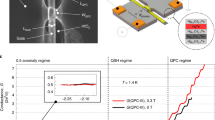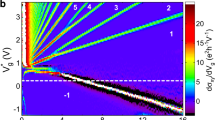Abstract
The edge of a two-dimensional electron system in a magnetic field consists of one-dimensional channels that arise from the confining electric field at the edge of the system1,2,3. The crossed electric and magnetic fields cause electrons to drift parallel to the sample boundary, creating a chiral current that travels along the edge in only one direction. In an ideal two-dimensional electron system in the quantum Hall regime, all the current flows along the edge4,5,6. Quantization of the Hall resistance arises from occupation of N one-dimensional edge channels, each contributing a conductance of e2/h (refs 7,8,9,10,11). Here we report differential conductance measurements, in the integer quantum Hall regime, of tunnelling between the edges of a pair of two-dimensional electron systems that are separated by an atomically precise, high-quality, tunnel barrier. The resultant interaction between the edge states leads to the formation of new energy gaps and an intriguing dispersion relation for electrons travelling along the barrier: for example, we see a persistent conductance peak at zero bias voltage and an absence of tunnelling features due to electron spin. These features are unexpected and are not consistent with a model of weakly interacting edge states. Remnant disorder along the barrier and charge screening may each play a role, although detailed numerical studies will be required to elucidate these effects.
This is a preview of subscription content, access via your institution
Access options
Subscribe to this journal
Receive 51 print issues and online access
$199.00 per year
only $3.90 per issue
Buy this article
- Purchase on Springer Link
- Instant access to full article PDF
Prices may be subject to local taxes which are calculated during checkout



Similar content being viewed by others
References
Prange,R. E. & Girvin,S. M. (eds) The Quantum Hall Effect 2nd edn (Springer, New York, 1990).
Das Sarma,S. & Pinczuk,A. (eds) Perspectives in Quantum Hall Effects (Wiley Inter-Science, New York, 1997).
Halperin,B. I. Quantized Hall conductance, current-carrying edge states, and the existence of extended states in a two-dimensional disordered potential. Phys. Rev. B 25, 2185–2188 (1983).
MacDonald,A. H. & Streda,P. Quantized Hall effect and edge currents. Phys. Rev. B 29, 1616–1619 (1984).
Apenko,S. M. & Lozovik, Yu. E. J. The quantized Hall effect in strong magnetic fields. J. Phys. C 18, 1197–1203 (1985).
Fontein,P. F. et al. Spatial potential distribution in GaAs/AlxGa1-xAs heterostructures under quantum Hall conditions studied with the linear electro-optic effect. Phys. Rev.B 43, 12090–3 (1991).
Buttiker,M. Absence of backscattering in the quantum Hall effect in multiprobe conductors. Phys. Rev. B 38, 9375–9389 (1988).
Streda,P., Kucera,J. & MacDonald,A. H. Edge states, transmission matrices, and the Hall resistance. Phys. Rev. Lett. 59, 1973–1975 (1987).
Jain,J. K. & Kivelson,S. A. Landauer-type formulation of quantum-Hall transport: critical currents and narrow channels. Phys. Rev. B 37, 4276–4279 (1988).
Haug,R. J., MacDonald,A. H., Streda,P. & von Klitzing,K. Quantized multichannel magnetotransport through a barrier in two dimensions. Phys. Rev. Lett. 61, 2797–2800 (1988).
Washburn,S., Fowler,A. B., Schmid,H. & Kern,D. Quantized Hall effect in the presence of backscattering. Phys. Rev. Lett. 61, 2801–2804 (1988).
Yacoby,A. et al. Non-universal conductance quantization in quantum wires. Phys. Rev. Lett. 77, 4612–4615 (1996).
Wildoer,J. W. G., Venema,L. C., Rinzler,A. G., Smalley,R. E. & Dekker,C. Electronic structure of atomically resolved carbon nanotubes. Nature 391, 59–62 (1998).
Odom,T. W., Huang,J., Kim,P. & Lieber,C. M. Atomic structure and electronic properties of single walled carbon nanotubes. Nature 391, 62–64 (1998).
Ishiguro,T., Yamaji,K. & Saito,G. Organic Superconductors 2nd edn (Springer, New York, 1998).
Tessmer,S. H., Glicofridis,P. I., Ashoori,R. C., Levitov,L. S. & Melloch,M. R. Surface charge accumulation imaging of a quantum Hall liquid. Nature 392, 51–54 (1998).
McCormick,K. L. et al. Scanned potential microscopy of edge and bulk currents in the quantum Hall regime. Phys. Rev. B 59, 4654–4657 (1999).
Goldman,V. J. & Su,B. Resonant tunnelling in the quantum Hall regime: measurement of fractional charge. Science 267, 1010–1012 (1995).
Tarucha,S., Honda,T. & Saku,T. Reduction of quantized conductance at low temperatures observed in 2 to 10 µm-long quantum wires. Solid State Commun. 94, 413–18 (1995).
Ho,T. L. Oscillatory tunnelling between quantum Hall systems. Phys. Rev. B 50, 4524–4533 (1994).
Wulf,U., Gudmundsson,V. & Gerhardts,R. R. Screening properties of the two-dimensional electron gas in the quantum Hall regime. Phys. Rev. B 38, 4218–4230 (1988).
Pfeiffer,L. N. et. al. Formation of a high quality two-dimensional electron gas on cleaved GaAs. Appl. Phys. Lett. 56, 1697–1699 (1990).
Chang,A. M., Pfeiffer,L. N. & West,K. W. Observation of chiral Luttinger behavior in electron tunnelling into fractional quantum Hall edges. Phys. Rev. Lett. 77, 2538–2341 (1996).
Acknowledgements
We thank S. M. Girvin for insight into the energetics of our 2D-2D device geometry. We also thank R. de Picciotto, A. M. Chang, T. L. Ho and J. P. Eisenstein for discussions.
Author information
Authors and Affiliations
Corresponding author
Rights and permissions
About this article
Cite this article
Kang, W., Stormer, H., Pfeiffer, L. et al. Tunnelling between the edges of two lateral quantum Hall systems. Nature 403, 59–61 (2000). https://doi.org/10.1038/47436
Received:
Accepted:
Issue Date:
DOI: https://doi.org/10.1038/47436
This article is cited by
-
New disordered anyon phase of doped graphene zigzag nanoribbon
Scientific Reports (2022)
-
Interplay between topological valley and quantum Hall edge transport
Nature Communications (2022)
-
Novel optical probe for quantum Hall system
Pramana (2006)
Comments
By submitting a comment you agree to abide by our Terms and Community Guidelines. If you find something abusive or that does not comply with our terms or guidelines please flag it as inappropriate.



